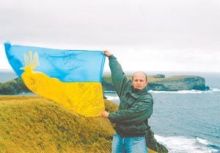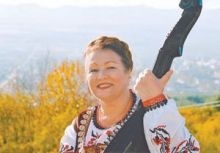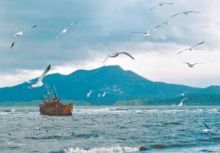Continued from previous issue
The first stage of Mykola Khriienko’s project “Ukrainians beyond the Urals” was the most difficult – it lasted the longest (seven months and four days) and was the most demanding (temperatures went from 41 above to 41 below Zero); there were long delays and places hard to get to, like the Dezhnev Cape which Khriienko only reached on his fifth attempt. But these difficulties persuaded Khriienko that he needed to go on. “On Dezhnev Cape I understood that it was too early to stop,” the journalist explained. “A vast region remained, Kamchatka, the Commander Islands, the Kuril Islands and Sakhalin, where as far as I knew many interesting Ukrainians were living.”
On June 16, 2007, the traveling journalist Khriienko, seeking unique, even shocking life stories of his fellow countrymen, set out for the second stage of his project “Ukrainians beyond the Urals,” which lasted till October 19, 2007. The end destination was Kunashir Island, located on the Kuril Islands. There and back Khriienko traveled 33,000 km.
However, at the beginning of the second stage he had to return to Kolyma. After publications about the first part of the tour, the shooting crew of the First National Channel (director: Oleksandr Riabokrys and cameraman Maksym Makovei) decided to make a documentary about Stalin’s Kolyma. “In a 21-day period we accomplished a huge amount of work: first in Magadan, then — on the famous Kolyma highway,” Khriienko explained. “We managed to go over deep steppes, crawled through impassable roads, made our way through snowy crossings by a high-powered jeep, covering 1,700 kilometers, everything owing to the Magadan resident Gennady Prudnikov. His reaction was like lightning, with a firm hand and filigree accuracy in actions under critical conditions.”
The work of the journalists in Kolyma was unprecedented, and will probably remain unrivaled in scale. They made video recordings of a gold mine Maldyak, where aircraft constructor Serhii Koroliov served an unfair sentence; in the village of Matrosovo, where Vasyl Stus was exiled and worked in a gold mine. They also visited the Dniprovsky concentration camp, where hundreds of OUN activists and UPA warriors were tortured to death. “There is a small stream nearby, it was called Dniprovsky, apparently by a Ukrainian,” Khriienko assumes, “Hence the name of the concentration camp.” But there is something ominous about the fact that the place of death and suffering of our fellow countrymen was named with such a dear and poetic word for every Ukrainian.
“Far away in the taiga, in a valley, in the prison camp, abandoned after Sta-lin’s death, there was a surrealistic picture in the style of Salvador Dali or Vereshchagin. In the yellow sand there were black graphics of shadows cast by bent posts and barbwire. Deep, with black shades, they bear traces, white human bones. River water, blindingly bright because of the sun, swift and noiseless. And silence. It is so silent there as if the guards executed time together with the prisoners. This is a place where one is afraid to stay alone,” Khriienko wrote these words about Kolyma for the magazine Neopalyma Kupyna (The Burning Bush) after he came back to Ukraine.
At the same time the journalist admits that this work was a very interesting experience, though it induced certain changes in his psyche. “When you set out alone, you get ready to work on your own. There is no romantics, just work, albeit in a specific form. But when after 21 days of joint work I said goodbye to the guys, and they boarded on a plane to go to Kyiv, I felt emotionally devastated. The whole burden of the future work was on my shoulders. But those were exclusively emotions, they did not find any reflection on my actions,” Khriienko explained.
The Pacific Ocean region lied ahead. Overall, Khriienko describes the second stage as a very bright one — autumn co-lors, golden sun, and mature people. He also remembered unforgettable acquaintances. For example, he met Rev. Yaroslav, the dean of the Sts. Peter and Paul Church in Petropavlovsk-Kamchatsky. Born in Stryi region, Rev. Yaroslav came to Kamchatka in 1985. At the time the city’s Orthodox parish counted some 20 believers, who prayed in a small house. The priest started to broaden the geography of Orthodox faith to the entire peninsula (which is 1,200 kilometers long from north to south, and 450 kilometers wide). It happened that the priest was on his way when night fell, so he had to spend the night in the open air with a frost reaching 40 degrees. Today he is an honored resident of Petropavlovsk-Kamchatsky. In the period of his service in Kamchatka he christened over 110,000 people.
Interestingly, Ukrainians managed to realize themselves even here, amidst the harsh wasteland. There are many Ukrainians among the entrepreneurs, deputies and teachers. “Here, on the faraway Bering’s Island, where I clung my root to this soil and stones, I preserved as the dearest treasure the embroidered shirt of my grandmother Tetiana Ivanivna and the rushnyks, embroidered by my mother Kateryna Ivanivna Baran,” wrote the Ukrainian Olha Veriutina in Khriienko’s diary. Together with her husband she has raised three sons and managed a proper household. “I will pass this trea-sure on to my children. They must remember that their family’s roots go back to Ukraine!”
Overall, Bering’s Island is Ukrainian in a special way. “Many Ukrainians there, once they saw the inscription ‘Ukraine’ on my jacket, approached me and with a friendly smile said, ‘I’m your fellow countryman. Let’s get acquainted,’” Khriienko recalls.
Alas, a newspaper’s space is limited. I would like you to learn about the Sakhalin’s hard labor camps, the tragedy of Neftegorsk, or Khriienko’s visit to the Kuril and Commander islands, as well as the unbelievable Ukrainians that the researcher met on his way — their outstanding destinies, wrought thousands of kilometers from their native land. But let us save more room for the unique shots made by the journalist.
One more detail, Khriienko remains in contact with everyone he met beyond the Urals. They are almost like a family to him, he is the only thread that links them with their fatherland. That is why it is no surprise that on December 31 he received New Year greetings from the faraway island Kunashir, where the New Year comes nine hours earlier.
In the coming issues read about the third stage of this unprecedented pro-ject: “Ukrainians beyond the Urals.”









